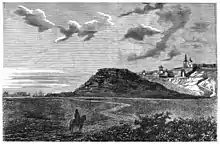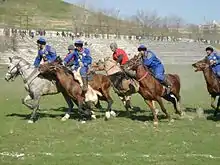 Kazakh shepherd with horse and dogs. | |
| Country of origin | Kazakhstan |
|---|---|
| Use | Riding, draft, meat, milk |
| Traits | |
| Weight |
|
| Height |
|
| Color | Bay, black, chestnut, gray, roan and cream gene |
The Adaev (Russian: Адаевская лошадь) is a horse breed for riding and light draft. It is native to the desert regions of southern Kazakhstan and is one of the two types of the Kazakh breed, along with the Jabe. Finer and less hardy than the Jabe, the Adaev is an "Oriental Turk" type. It is mainly used for local equestrian sports and herding. Mares are milked for their milk. Like most Kazakh horses, the Adaev is sometimes slaughtered for its meat, although this is only a secondary purpose. Little known outside its native area, the Adaev has spread to neighboring Turkmenistan and Uzbekistan, with nearly 29,000 individual horses counted in 1990.
History

"Adaev" is the international name, the breed is also known as Adayev and, in Russian, Adaevskaya lochad.[1] It received this name from a Kazakh military tribe, the Adaï (Адай, in Russian), well known in Central Asian history.[2]
The Adaev may have been influenced by the Turkoman horse[1][3] and has more recently experienced the influence of the Don horse, the Thoroughbred and the Orlov trotter.[4] The breed has suffered a population decline due to uncontrolled crossbreeding. At the end of the 20th century, a breeding program was set up to improve the quality of the herd, notably by increasing the size and fertility of the horses, through the provision of feed and the establishment of pedigrees.[4] This "improver" breeding became established in the Guryev region.[5]
In 2011, at the Akbastau border in the Mañğıstaw oblys, state tests were carried out on Adaev horses.[6] Horses were selected from thousands of representatives of this breed.[6] The thirty-six animals considered the most deserving were admitted to the tests and had to cover 90 kilometers during the day. Every 15 kilometers, jury members and veterinarians examined these horses.[6] They measured blood pressure, pulse and degree of perspiration.
Description

A steppe horse, the Adaev is considered locally to be a type of the Kazakh breed,[7][2] adapted to the saddle, rather than a breed in its own right.[4] It is further away from the original Kazakh horse than the Jabe,[7] and zootechnically belongs to the Turkoman horse group, with an "Eastern Turk" type,[8] due to its crossbreeding with Turkoman horses.[9]
There are three types of Adaev: massive, medium and light;[10] overall, the model is rather light,[1] with a dry constitution.[2] Height ranges from 1.32 m to 1.43 m according to Hendricks (2007);[4] 1.32 m to 1.44 m according to CAB International (2016);[8] 1.36 m to 1.40 m according to the Great Soviet Encyclopedia[5] and the Delachaux guide.[11] Average weight is 360 kg for females and 370 kg for males, according to the DAD-IS database.[1] The foal weighs between 39 and 50 kg at birth; growth lasts 5 years on average, and is strongest during the first six months of life.[12]
The head is often Roman in profile,[10] slender and light, with bright, wide-set eyes.[1] Ears are straight and agile.[1] The neck is long and fine, straight and set fairly high.[1][13] The withers are well defined and prominent, the back generally straight.[1] The topline is of good quality, the body deep and the ribs rounded.[1] The croup is often swollen, but well muscled.[1] The hind legs are of good quality, with well-developed joints and clearly visible tendons.[1] The skin is dense,[1] and the coat grows thickly in winter.[11] Some poorly bred or deficient horses have narrow chests and few bones.[4]
Coat colors can be very varied, from bay to chestnut, black, gray, roan and palomino.
Usually raised in herds (taboons),[4] they are well adapted to the environmental conditions of the deserts[14] of southern Kazakhstan, where they survive all year round by grazing on vegetation,[1] and can go several days without drinking.[15] Its ability to adapt to extreme breeding conditions, as well as its endurance, are considered exceptional.[16] However, it is less resistant than the Kazakh[4] and Jabe horses.[11] Its fattening capacity during the summer months has been measured: between May-June and October-November respectively, the average daily weight gain was 916 to 667 grams for the group of one-year-old foals, 870 to 711 grams for the group of two-year-old foals, and 750 to 600 g for adult females.[17]
The breed is renowned for its high fertility, over 90%.[1] Mares start breeding at the age of two, and foals are usually born in April and May.[12]
Some Adaevs have additional gaits.[11] The best Adaevs are agile and have light gaits.[2] The stride is rather short, with some elevation of the forelegs.[2]
The temperament is said to be gentle, with a quick attachment to its rider.[2]
Uses

The Adaev is mainly intended for local equestrian sports.[1] It is more suited to the saddle than the Jabe, although it can also be hitched to light harnesses.[18] The horse's pulling power is limited, but still considerable in relation to its size and weight.[19]
These horses are also used to work cattle and guard sheep herds.[8]
They are also slaughtered for their meat,[4][8] a purpose that mainly concerns the massive type of the breed,[10] as the meat yield of Adaevs is generally poor.[11]
Mares, on the other hand, are renowned for their milk production, which is then processed into kumis,[10] with a high yield.[18] The Great Soviet Encyclopedia estimates that mares give 11 to 14 liters of milk a day.[5] The Adaev has been used in crossbreeding with the neighboring Jabe breed.[4]
Distribution

Considered a regional Asian breed, its area of presence is located between the Caspian Sea and the Aral Sea,[1][2][3] historically corresponding to desert plains[20] in the administrative region of the Mañğıstaw oblys.[16] In 1985, around 27,000 horses were counted.[4] A highly accurate population count was carried out in 1990, counting 28,949 Adaev horses in Kazakhstan, with a trend towards stability. There were also 772 Adaev stallions in operation that year, with 12,772 breeding mares, 44 of them purebred. In 2006, the Adaev was considered one of the two most widespread horse breeds in Kazakhstan, along with the Jabe.[21]
It is little known outside its native area.[11]
See also
References
- 1 2 3 4 5 6 7 8 9 10 11 12 13 14 15 16 DAD-IS.
- 1 2 3 4 5 6 7 "Адаевская порода лошадей". konevedia.ru (in Russian). Retrieved 1 August 2019.
- 1 2 "АДАЕВСКАЯ ЛОШАДЬ - это... Что такое АДАЕВСКАЯ ЛОШАДЬ?". Словари и энциклопедии на Академике (in Russian). Retrieved 2 August 2019.
- 1 2 3 4 5 6 7 8 9 10 Hendricks 2007, p. 3.
- 1 2 3 Grande Encyclopédie soviétique.
- 1 2 3 "Адаевские лошади". YouTube (in Russian). Retrieved 2 August 2019.
- 1 2 Porter et al. 2016, p. 479.
- 1 2 3 4 Porter et al. 2016, p. 432.
- ↑ Misarev, A. (18 February 1945). "The Adaev horse". Socialist, seljsk. Hoz. Retrieved 3 August 2019.
- 1 2 3 4 Hendricks 2007, p. 4.
- 1 2 3 4 5 6 Rousseau 2014, p. 312.
- 1 2 Imangaliev, A. (23 June 1961). "The Adaev horse". Konevod. konnyi Sport. Retrieved 3 August 2019.
- ↑ Rousseau 2014, p. 313.
- ↑ Киладзе, Андрей; Чернова, Ольга; Перфилова, Татьяна; Спасская, Н.; Ибраев, М. (2017). Атлас микроструктуры волос лошадей (in Russian). Litres. p. 11. ISBN 978-5040706068.
- ↑ "Адаевская лошадь". zooglobal.ru (in Russian). Retrieved 2 August 2019.
- 1 2 "Успехи и провалы казахстанских фермеров". BN (in Russian). Retrieved 2 August 2019.
- ↑ Karashin, M.; Ryszhanov, K. (15 April 1976). "Pasture fattening of Adaev horses". Konevodstvo i Konnyi Sport. Retrieved 3 August 2019.
- 1 2 Pickeral 2003, p. 220.
- ↑ Sadykov, B. H. (11 January 1958). "The performance of Adaev horses". Sborn. nauc. Trud. semipalatinsk. zooteh.-vet. Inst. Retrieved 3 August 2019.
- ↑ сельского хозяйства, Московское общество; библиотека, Центральная сельскохозяйственная; Иванова, Алла Анательевна; Подвойский, И. И. (1954). Опыт и достижения новаторов животноводства: Коневодство; указатель литературы (in Russian). Гос. изд-во культурно-просветительной лит-ры. p. 67-68.
- ↑ Semioshkina, N.; Voigt, G.; Fesenko, S.; Savinkov, A. (1 January 2006). "A pilot study on the transfer of 137Cs and 90Sr to horse milk and meat". Journal of Environmental Radioactivity. 85 (1): 84–93. doi:10.1016/j.jenvrad.2005.06.001. ISSN 0265-931X. PMID 16260333.
Bibliography
- Hendricks, Bonnie Lou (2007). International Encyclopedia of Horse Breeds: Adaev. Norman: University of Oklahoma Press. pp. 3–4. ISBN 978-0806138848. OCLC 154690199.
- Kosharov, A. N.; Pern, E. M.; Rozhdestvenskaya, G. A. (1989). Animal Genetic Resources of the USSR. Animal Production and Health Paper Publ: Horses. Rome: FAO.
- Pickeral, Tamsin (2003). Encyclopedia of horses and ponies. Barnes & Noble Books. p. 220. ISBN 0760734577..
- Porter, Valerie; Alderson, Lawrence; Hall, Stephen J. G.; Sponenberg, D. Phillip (9 March 2016). Mason's World Encyclopedia of Livestock Breeds and Breeding (6th ed.). CAB International. ISBN 978-1-84593-466-8. OCLC 948839453. OL 29071452M.
- Rousseau, Elise (September 2014). Tous les chevaux du monde (in French). Illustrator: Yann Le Bris. Delachaux et Niestlé. ISBN 978-2-603-01865-1. OL 26720039M.
- "Adaev / Kazakhstan (Horse)". Domestic Animal Diversity Information System of the Food and Agriculture Organization of the United Nations (DAD-IS).
- "Адаевская лошадь" (in Russian). Great Soviet Encyclopedia. Retrieved 2 August 2019.